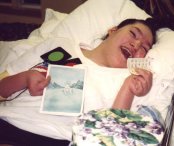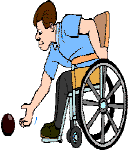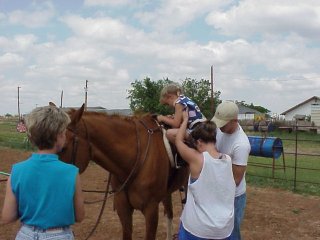The Cerebral Palsy Network
- Cerebral Palsy
- Hippo therapy
- Pediatric Stroke
- School Daze
- HBOT
- SDR
- Spasticity Management
- Cephalic Disorders
- CP & Aging
- BOTOX
Around CPN
Resource
Center
Katherine is our model for hippo therapy. A special thank you to her and her mom.
Hippo therapy is taken from the Latin word for horse. Hippo Therapy benefits a wide range of adults and children with varying degrees of physical, cognitive and or emotional disabilities. Cerebral Palsy being one of those. It originated in Germany in the 1600's before it came to North America in the 1960's. There are now many accredited centers through out the United States and Canada.
Why it Works
A horses gait (walk) is close to a human gait. The forward movement with the hip/pelvis moving left to right, back and forth and tilting forward and backward is the same as when a human walks. By sitting passively on the horse the childís pelvis receives all the movement as if they were walking. It reproduces all of the components of walking by experiencing normal movement. Because children with cerebral palsy usually do not develop in the same manner as a child without disabilities IE: sitting, pulling up, crawling, kneeling, furniture walking, then walking, their brain does not know what it is supposed to feel like. The brain perceives these different stages of development and records it. If someone doesnít go through these different stages of development, the information isnít there. When you place a child with CP or another type of disability where this information was not "input" or was lost by a head injury, being it a stroke or other type of disability it is another way to get the information to the brain. I always explain it as "It kick started her brain".
Equipment used with Hippo Therapy
There is different equipment used for hippo therapy. A child could ride bareback with a sheepskin bareback pad. This allows the Therapist to put the child in many different positions on the horse. This could be facing forward, backward sideways. Laying down or over the horse. Once again, these different positions give the brain different information while working different muscle groups. The therapist may use wedges for a child that is trying to improve their balance or harness with handles for the child to hold onto to support themselves when working on improving trunk control. This type of hippo therapy is usually done with someone "driving" the horse from behind as well as with the two side walkers. Children that have trunk control and can ride unassisted may use a saddle. As always with the side walkers also. As well as learn how to use reins. Rings and balls are also used to help with reaching and stretching. Depending on what the therapist is working on and what therapy they want to accentuate, as well as the abilities of the child determines which equipment is used.
Benefits of Hippo Therapy
Besides the obvious benefit that itís fun! It also helps to gain confidence, self esteem, flexibility, balance and muscle strength. The smooth, gentle, rhythmic movements of the horse helps to reduce spastic muscles, and build muscle strength, which in turn improve balance and sitting, that in turn helps to improve speech. because it improves the balance, which improves coordination of breathing, which improves better lung capacity, which improves speech. It builds the confidence as they gain better control of their bodies and become more aware of the world around them. Self esteem is improved as they reach their goals that were/are set. Most kids donít horse back ride so it also is a huge self esteem booster when their friends find out that they "ride".
Accredited vs. Non Accredited
It is highly recommend that if you do have your child in a hippo therapy program that it is accredited. What that means is they have gone through a process that has high standards and practices that must be followed. There are licensed therapists that will be assigned to your child. A formal assessment is done and a individual program is set up for your childís specific needs. The child is usually not required to be able to sit unassisted on the horse. The Therapist is a back rider until the child is able to sit unassisted on the horse. They provide side walkers on each side of the horse for added safety. Most insurance companies recognize the accredited programs and will cover it as therapy. Some programs also offer scholarship programs and parents pay what they can afford. Most sessions last for 30 minutes and are done 1-2 a week. A helmet is required. It doesnít have to be a special riding helmet, bike helmets are usually acceptable.
A program that is not accredited is usually group oriented or the child must be able to sit unassisted. Since they usually donít have licensed therapist that work one on one with the child they are not usually aware of the therapeutic aspects of hippo therapy. An excellent web sit is http://www.NARHA.org This is for the North American Riding for the Handicapped Association. It is not only a extremely informative site it also has all the centers in the United States and Canada listed. They are listed by region. The centers that have a * next to their names are the accredited programs. They also are listed with address, phone numbers and web pages if they have one.
Credit for this report goes to Vicki Hendrickson our special thanks for your time and effort you put into CPN and to Katherine for letting us use her as a model.
This site designed & maintained by Mystic Dawn Web Creations. The Cerebral Palsy Network©1997/2003. All graphics are the exclusive property of CPN, unless otherwise indicated. Contact CPN at Cerebral Palsy Network for further information.
Last updated 03/24/03

Amanda the reason CPN was
started
CPN
Reunion 2003

CP
Research
What's happening Today with
Cerebral Palsy

Special
Olympics
What's happening with
Special Olympics in 2003

CP
& Education
What's happening with
Special Need and Education in 2003


